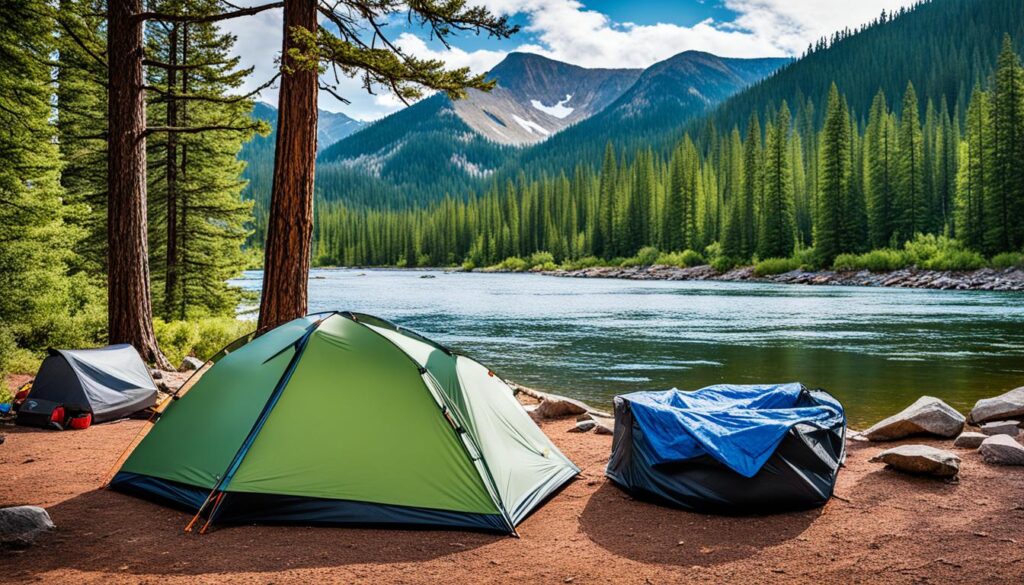Getting ready for my camping trip filled me with excitement. I love the outdoors for its peace and adventure. But this time, I had to choose. Should I take a footprint tent or a tarp? This choice would ensure my campsite’s comfort and safety, and I was set on making the best pick.
Footprint tents and tarps play key roles in camping gear. A tent footprint is a ground cloth that protects the tent from wear and tear. It prevents the tent floor from getting damaged by moisture, abrasions, and punctures. Meanwhile, a tarp is waterproof and can act as shelter from above, provide shade, or turn into an emergency shelter.
After thorough research, I understood that the choice depends on the type of camping, the weather, and what I prefer. This decision could greatly impact my adventure travel and how ready I am for such trips.
Key Takeaways
- Footprint tents and tarps serve different purposes in outdoor camping gear.
- Tent footprints protect the tent floor from damage, while tarps provide versatile shelter and shade.
- The choice between a footprint tent and a tarp depends on factors like camping activity, weather, and personal preference.
- Proper care and maintenance are crucial for maximizing the lifespan of both tent footprints and tarps.
- Considering the key factors like material, weight, and weather resistance can help campers make an informed decision.
Understanding Tent Footprints and Tarps
The choice between tent footprints and tarps is a key discussion for campers. Understanding their roles and benefits is vital. This knowledge helps in selecting the right equipment for your camping trips.
What is a Tent Footprint?
A tent footprint acts as a protective shield under your tent. It’s often named a ground cloth or tarp. This strong, waterproof barrier guards the tent floor from getting damaged. It protects against rough, moist, or bumpy ground. Using a footprint can make your camping adventures last longer and feel more comfortable.
Purpose and Benefits of a Tent Footprint
A tent footprint offers extra protection for your tent’s base. It’s a sturdy, waterproof barrier that prevents damage from sharp objects. A footprint also stops the tent floor from getting wet. This keeps the tent dry, even on wet or rainy ground.
What is a Tarp?
A tarp is an all-purpose piece of outdoor gear. It’s often crafted from materials like nylon or polyester to be waterproof. It’s used to make an overhead shelter, shaded area, or emergency shelter.
Versatility and Advantages of Tarps
Tarps are known for their versatility. They can do more than just protect the tent floor. You can use a tarp to set up shade, cover above you, or provide shelter quickly. They are light and easy to pack, making them ideal for backpacking and lightweight adventures.
Footprint Tent vs Tarp: Key Considerations
When you pick between a tent footprint and a tarp for the next time you head outdoors, remember a few things. Think about the material durability, weight and packability, weather protection, and waterproofing they offer. Each option has its strengths.
Material and Durability
The strength of the material used in a tent footprint or tarp is very important. It decides how well the item will last against the weather and avoid damage. Footprint tents are usually from strong materials like polyester or nylon. These materials offer a solid barrier, protecting your tent from the ground. Tarps, however, use materials like ripstop nylon or polyethylene. They are known to be very durable and offer great protection against the weather.
Weight and Packability
Considering the weight and packability of a tent footprint or tarp is key, especially for hikers and those wanting to pack light. Tent footprints are light and easy to carry, helping reduce the total weight of your gear. They don’t take up much room in your pack either, saving space for other essentials. Tarps, although not as compact as footprints, prove to be versatile. They offer many shelter options for different camping needs.
Weather Protection and Waterproofing
How well a tent footprint or tarp can handle the weather is very important, especially during rough conditions. Tent footprints guard the tent floor against moisture. Tarps, however, provide cover above your head. They make sure you have a dry spot, proving very useful when the weather turns bad.
footprint tent vs tarp: Scenarios and Use Cases
Choosing between a footprint tent and a tarp depends a lot on what kind of camping you plan to do. The decision is key for different types of outdoor activities. Let’s look at various scenarios to pick the right gear for you.
Backpacking and Lightweight Adventures
Tarps shine in backpacking and lightweight adventures. They are light and easy to carry. This makes them perfect for long trips into nature. Plus, tarps are super versatile. You can set them up in different ways to fit various camping scenarios you might run into.
Car Camping and Family Trips
If your plan is car camping or family outings, a footprint tent might suit you better. These tents offer better protection against the elements. They also give you a dedicated sleeping space, which is great for comfort on longer stays. This is especially true when camping with children.
Extreme Weather Conditions
For times when you expect extreme weather, like heavy rain or snow, a footprint tent is your go-to. These tents, with their added protection from the ground up, keep the inside dry. They’re built tough to withstand rough weather, making your stay more enjoyable. Even in the wildest outdoor environments, you’ll be glad to have one.
Maximizing Tent and Tarp Lifespan
To make your tent, tarp, and camping gear last longer, take good care of them. Proper tent care and maintenance and tarp care and maintenance are key. By doing some easy care steps, you’ll have your gear ready for many trips.
Proper Care and Maintenance
Keep your tent and tarp clean and check on them often. After using them, use a damp cloth to wipe off dirt and grime. Don’t use harsh soaps that can harm their waterproof materials. Let them dry fully before putting them away.
Storage and Packing Tips
How you store and pack your gear is crucial. Don’t fold them the same way every time; this can damage them. It’s better to roll or gently fold them. Keep them in a cool and dry spot, not in direct sun. And when moving them, watch out for sharp items or things that could rip the fabrics.
When to Replace or Upgrade
Sometimes, despite your care, your gear might need a new version. Watch for signs like tears or fading. If your gear is no longer keeping you dry or warm, it might be time to get something new. If you use your gear a lot, upgrading to a sturdier option could be a good move.
Conclusion
In the debate between footprint tents and tarps, there’s no easy answer. The best pick depends on your camping scenario and what you like. If you want to protect your tent from getting wet and torn, tent footprints are great. They’re perfect for those backpacking or going on lightweight adventures.
But if you’re looking for something versatile, you might prefer tarps. They can work as outdoor shelter and weather protection. This makes them a solid choice for car camping and family trips, especially when the weather gets rough. Think about things like how durable it is, how light and easy to pack, and how it holds up against the weather. This will help you choose the best camping gear for your outdoor adventures. You’ll be comfortable and safe.
The final call between a footprint tent and a tarp is up to you. It depends on what you need from your camping trip and how you like to camp. If you take good care of your tent accessories and outdoor equipment, they can last a long time. And you’ll be ready for camping every year.
Recommended
- BEST BED TENT TO BLOCK OUT LIGHT FOR SLEEP
- BED TENT FOR TRAVEL: SLEEP COZY ON-THE-GO
- INDOOR BED TENT FOR CAMPING COMFORT & FUN

Meet Noah, the soul behind “Best Inflatable Tent” and a true wanderer at heart. Living the van life, Noah has turned his passion for exploring the great outdoors into a lifestyle, earning his living through organizing group travels that bring people closer to nature. With years of firsthand experience in the wild, Noah’s expertise in selecting and utilizing inflatable tents is unparalleled. Through this blog, he shares his profound knowledge and practical tips to help fellow adventurers find their perfect outdoor shelters. Noah’s commitment to delivering genuine, tested insights has made him a trusted authority in the camping community. Join him on this journey to discover the best inflatable tents that make the great outdoors feel like home.
